
Pac-Man, originally called Puck Man in Japan, is a 1980 maze video game developed and released by Namco for arcades. In North America, the game was released by Midway Manufacturing as part of its licensing agreement with Namco America. The player controls Pac-Man, who must eat all the dots inside an enclosed maze while avoiding four colored ghosts. Eating large flashing dots called "Power Pellets" causes the ghosts to temporarily turn blue, allowing Pac-Man to eat them for bonus points.

Pole Position is a racing arcade video game released by Namco in 1982. It was licensed to Atari, Inc. for US manufacture and distribution. Pole Position is considered one of the most important titles from the golden age of arcade video games. It was an evolution of Namco's earlier arcade racing electro-mechanical games, notably F-1 (1976), whose designer Sho Osugi worked on Pole Position.

Xevious is a vertically scrolling shooter arcade video game developed and published by Namco in 1982. It was released in Japan by Namco and in North America by Atari, Inc. Controlling the Solvalou starship, the player attacks Xevious forces before they destroy all of mankind. The Solvalou has two weapons at its disposal: a zapper to destroy flying craft, and a blaster to bomb ground installations and enemies. It runs on the Namco Galaga arcade system.

Popeye is a 1982 platform game developed and released by Nintendo as an arcade video game. It is based on the comic strip of the same name created by E. C. Segar and licensed from King Features Syndicate. Some sources claim that Ikegami Tsushinki did programming work on the game. As Popeye, the player must collect hearts thrown by Olive Oyl from the top of the screen while being chased by Bluto. Popeye can punch bottles thrown at him, but can only hurt Bluto after eating the one can of spinach present in each level. Unlike Nintendo's earlier Donkey Kong games, there is no jump button. There are three screens.
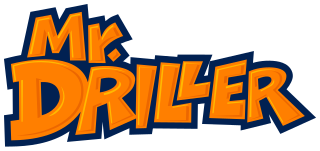
Mr. Driller is a puzzle video game franchise created by Yasuhito Nagaoka and Hideo Yoshizawa for Namco. The eponymous first game was released in 1999 for arcades and several home consoles, such as the PlayStation. Gameplay in the series consists of controlling Susumu Hori, the titular Mr. Driller, or one of his friends and destroying colorful formations of blocks to make it to the bottom of a well. In order to survive, players need to collect air capsules to replenish their depleting oxygen and avoid being crushed by falling blocks.

Pac-Man World 2 is a video game developed and published by Namco Hometek for the Xbox, GameCube, and PlayStation 2, released in 2002. A version of the game for Microsoft Windows was released in 2004, and an isometric sidescroller was made for the Game Boy Advance in 2005. The game is a sequel to Pac-Man World (1999). The game is a platform game, where the player controls Pac-Man in a 3D platforming environment, through six worlds. In 2005, a sequel, Pac-Man World 3, was released.
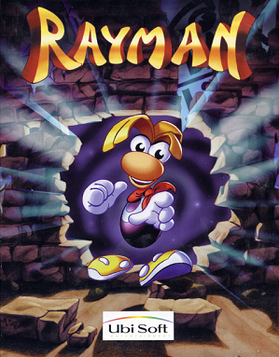
Rayman is a 1995 platform game developed by Ubi Pictures and published by Ubi Soft. It is the first installment in the Rayman franchise. The player controls Rayman, who must recapture Electoons and the Great Protoon after being told that Mr. Dark kidnapped them and uses its power to wreak havoc. Rayman gains new abilities throughout the game and the completion of each world requires defeating a boss with special abilities.
Namco Museum is a series of video game compilations developed and published by Bandai Namco Entertainment for home video game consoles. The first title in the series, Namco Museum Vol. 1, was released for the PlayStation in 1995. Entries in the series have been released for multiple platforms, including the Game Boy Advance, PlayStation 2, PlayStation Portable, Nintendo DS and Xbox 360. the latest being Namco Museum Archives Vol. 2, released in 2020.

Konami Krazy Racers is a kart racing video game published and developed by Konami for the Game Boy Advance handheld video game console. It was first released in Japan, and was later released in North America and some PAL regions. It was also re-released for Wii U Virtual Console on October 15, 2015 in Europe. It was a launch game for the system. Konami Krazy Racers makes use of a variety of characters and concepts from several of Konami's franchises, including Castlevania, Metal Gear, and Gradius. It plays similarly to the Mario Kart series, with eight characters per circuit and offensive/defensive items placed at predetermined points in the tracks.
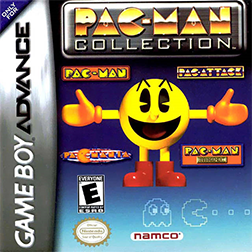
Pac-Man Collection is a 2001 video game compilation developed by Mass Media and published by Namco for the Game Boy Advance. It includes four titles in the Pac-Man series — the original Pac-Man (1980), Pac-Mania (1987), Pac-Attack (1993), and Pac-Man Arrangement (1996), the last of which was originally exclusive to the arcade game Namco Classic Collection Vol. 2. Each game includes customizable features such as the ability to alter the number of starting lives or difficulty, with all being stripped of multiplayer features.

Sigma Star Saga is a 2005 hybrid science fiction role-playing-space-shooter developed by WayForward Technologies and published by Namco for the Game Boy Advance. The player explores a standard 2-D overworld, but is transported into space for side-scrolling shooter random battles. The story focus on a space pilot named Ian Recker who goes undercover against Earth's enemies, the Krill, in a battle to save the planet.
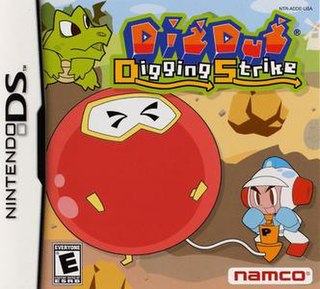
Dig Dug: Digging Strike is a 2005 maze video game published by Namco for the Nintendo DS. In Europe, the game was published by Atari Europe. It is the fifth entry in the Dig Dug video game series, and the second to be made for a home platform. The game follows series protagonist Taizo Hori, bitter about his son Susumu getting more attention than him—after a chain of tropical islands is threatened by monsters, Taizo sets out to defeat them and reclaim his fame. Gameplay combines mechanics established in the original Dig Dug and its sequel Dig Dug II, centered around sinking a large "boss" character into the ocean by digging under large stakes in the ground.

Backyard Football is a series of video games for various systems. The series was developed by Humongous Entertainment and published by Infogrames, Atari, and The Evergreen Group. It is one of several sub-series in the Backyard Sports franchise and is the first to feature professional players as kids, examples being Steve Young and Barry Sanders. The series currently has eleven titles.
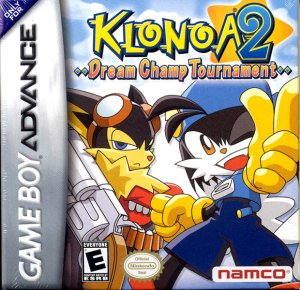
Klonoa 2: Dream Champ Tournament is a video game published by Namco and released on the Game Boy Advance in Japan in 2002 and North America in early 2005. As the third game in the Klonoa handheld series, the game retains many of the gameplay elements of the previous titles, while adding in a few of its own.
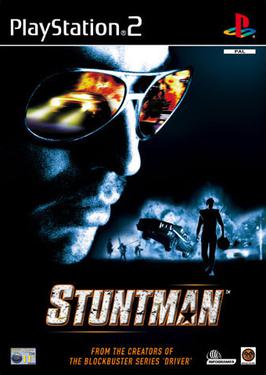
Stuntman is the name of two action-adventure racing video games; one was developed by Reflections Interactive for the PlayStation 2, and the other by Velez & Dubail for the Game Boy Advance, with both being published by Infogrames under the Atari brand name. The games focus around the career of a motion-picture stuntman. It takes the player through various movies in which they perform dangerous stunts as called by the game.

Rebelstar: Tactical Command is a turn-based tactics video game developed by Codo Technologies and published by Namco and Atari Europe for the Game Boy Advance in 2005. It's the fourth game in the Rebelstar series. The game was created by Julian Gollop, who previously designed X-COM: UFO Defense, Laser Squad and the original Rebelstar games.
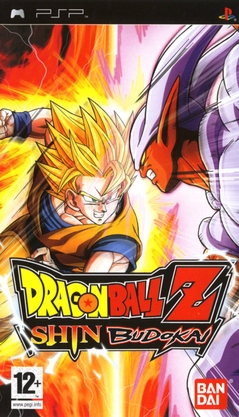
Dragon Ball Z: Shin Budokai is a fighting video game part of the Dragon Ball Z franchise, and was released on March 7, 2006, developed by Dimps. The story mode is based on the events of the Dragon Ball Z movie Fusion Reborn. The players follow the events of the story in which they encounter many Dragon Ball Z characters, including Goku and Vegeta. The choices that you make determine how the story evolves.

Street Racing Syndicate is an open world multiplatform racing video game produced by Eutechnyx, and released by Namco on August 31, 2004, for the PlayStation 2, GameCube, Xbox and Windows-based personal computers. A separate version of the game was also released for the Game Boy Advance on October 4, 2005. During its release, it was meant to compete against Need for Speed: Underground 2, the sequel to the critically acclaimed first game released in 2003.

Ace Combat Advance is a 2005 combat flight simulation video game in the Ace Combat series. Developed by Hungarian studio Humansoft, it is the first entry in the series released on a handheld game console and the first 2D entry in the series. Unlike other Ace Combat games, Advance was not released in Japan. It received mixed reviews from critics.

V-Rally 3 is a racing video game developed by Eden Studios and published by Infogrames Europe. It was released for the PlayStation 2 and Game Boy Advance platforms in 2002, and ported to the Xbox, GameCube, and Microsoft Windows in 2003.


















